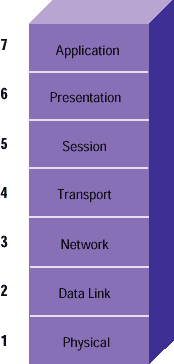
OSI Reference Model
Developed by International Standards Organization (ISO) and stands for Open Systems Interconnection (OSI).It is designed to deal with connecting open systems to communicate with other systems.It consists of seven layers: a complex structure is partitioned into a number of independent functional layers.Each layer provides a set of services by performing some well-defined sets of functions. These services are provided by the layered-specific functional entities.Services at a layer can only be accessed from the layer immediately above it.Each layer uses only a well-defined set of services provided by the layer below.Protocols operate between "peer" entities in the different end systems (peer-to-peer protocol rules)
Advantages:
More manageable -Layer N is smaller and built only on Layer (N-1).Modularity - Different layers can be developed separately and each layer can be modified without affecting other layers as long as the interfaces with immediate layers are kept
More manageable -Layer N is smaller and built only on Layer (N-1).Modularity - Different layers can be developed separately and each layer can be modified without affecting other layers as long as the interfaces with immediate layers are kept
Brief Description of model in Each Layer
The physical layer is responsible for passing bits onto and receiving them from the communication channel.This layer has no understanding of the meaning of the bits, but deals with the electrical and mechanical characteristics of the signals and signalling methods.
Data Link Layer
Data link layer is responsible for both Point-to-Point Network and Broadcast Network data transmission. It hides characteristics of the physical layer (e.g. transmission hardware from the upper layers.It is also responsible to convert transmitted bits into frames It transmits the frames into an error free transmission line by adding error control and flow control.
Network Layer
Network layer is responsible for the controls of routers and subnets operation. It also handles the formation and routing of packets from source to destination with congestion control.
Transport Layer
Transport layer is a kind of software protocol to control packets delivery, crash recovery and transmission reliability between sender and receiver.Multiplexing between transport and network connections is possible.
Session Layer
Session layer provides dialogue control and token management.
Presentation Layer
When data is transmitted between different types of computer systems, the presentation layer negotiates and manages the way data is represented and encoded.Essentially a 'null' layer in case where such transformations are unnecessary.
Application Layer
This top layer defines the language and syntax that programs use to communicate with other programs. For example, a program in a client workstation uses commands to request data from a program in the server.
Common functions at this layer are opening, closing, reading and writing files, transferring files and e-mail messages, executing remote jobs and obtaining directory information about network resources.


